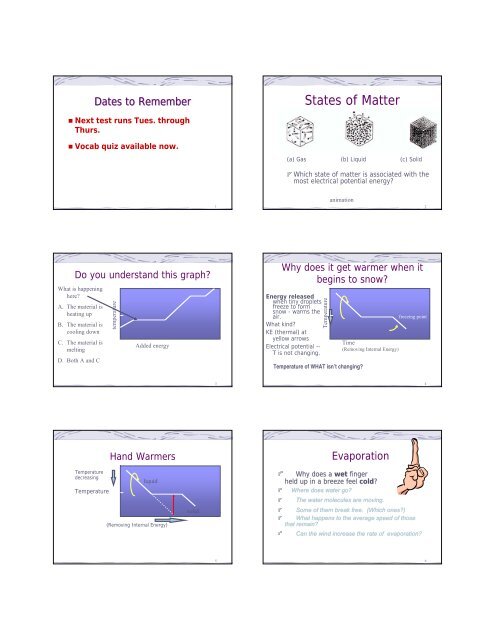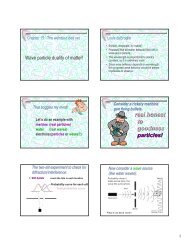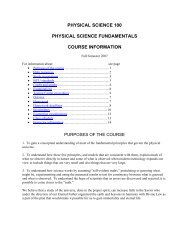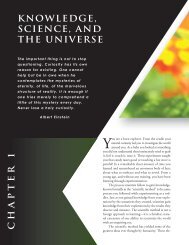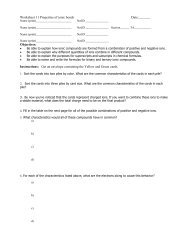chapter 14
chapter 14
chapter 14
Create successful ePaper yourself
Turn your PDF publications into a flip-book with our unique Google optimized e-Paper software.
Chapter 15-The Nuclear AtomA continuing saga in the development ofmodels to explain the structure of matter.Where we’ve been:Continuous modelAdvantage – simple, describes states of matterDisadvantage – Can’t turn lead into goldMolecular / atomic modelAdvantage – explains temperature, phase changes,Brownian motion, etcDisadvantage – too complex, can’t explain lightemission.7 8Then along cameThompson ...Here’s where hestarted.9Molecular Model of Matter1. Matter is made up of small, unseenparticles called molecules.2. Each kind of matter is made up of adifferent kind of molecule.3. The molecules are in constant motion --they jiggle, collide and rebound due toelectromagnetic forces.4. The motion and interaction of moleculescan be analyzed, understood and predictedby using the laws of force and motion andthe laws of conservation.10Start with point #1J.J. Thomson discovers the electronIs matter really made up of atoms andmolecules, or is there somethingsmaller?Can you break atoms and moleculesinto fragments?1112
Gas Discharge Tube+ --+-- + --++Showed matter was made up ofcharged piecesnegative particles are identicalsmall mass; electronspositive particles differ depending on gaslarge masseven small differences with same gas+What were the positive particles?A. ProtonsB. NucleiC. Atoms missing a few electrons13<strong>14</strong>Thomson Model of Atom(Plum Pudding Model)Atoms consist of a thin positive fluid, which containsmost of the mass, with embedded point-likenegative electrons to balance the chargePositive goopNegative particles15Two more experimentsThe ‘Milikan’ oil drop experimentShowed that charge is ‘quantized’ (a bigword meaning it comes in certain sizedlumps)Mass spectrometersShow that mass is ‘quantized’Time-of-Flight Mass Spectrometerpulse accelerator platespositiveparticlessame kinetic energy+ -Length of flight pathdetectorkinetic energy = 1/2 (mass)(speed) 2Heaviest particles move slowest1718
RESULT:the masses of different atoms!!!Testing the Thomson modelThe Rutherford experimenttimemass comes in lumpsThe art of figuring out what’s inside by shooting at it.1920Rutherford experimentResults:Rutherford’s Experiment 1911Video clip“It was like shooting at ghosts!” Asexpected, most went right on through.But, unexpectedly, a few bounced back!2122So, what is inside?Either plum pudding can ricochet bullets,or there is something else in the box.What would repel + charged bullets?A dense + charged nucleusIf all of the + charge is in the middle,where do you put the electrons?Make them orbit like planets around the sun.What do you call a model of the atomthat looks like the solar system?What would happen if you shotelectrons?A. They’d do the same thing that thealpha particles did.B. They’d all bounce off.C. They’d all go through.D. They’d all get absorbed by the gold.2324
The solar system model of the atom1. there are positive and negative parts*Thomson model2. the positive part is a tiny, dense nucleus3. the negative parts are electrons around thenucleus, orbiting wherever they want.4. the atom is mostly empty spaceAt nuclear density, a pin would weigh as much as abattleship.Problem: Still can’t explain why atoms emitunique, discrete spectraNot only that, but accelerating (orbiting) electronsshould continually radiate, loose energy, and spiralinto the nucleusHowever, if electrons are stationary, they’d fall intothe nucleus too.2526Bohr’s Answer(helpful but still imperfect)Niels Bohr: Nobel Prize 1922The Rutherford model + a patch.Electrons move in certain “allowed” orbits only --“quantized”. Don’t know why!Electron has a characteristic energy depending onorbit; smaller radius, less energy.Electrons radiate (emit) only when they jump toan allowed orbit of lower energy.Electrons absorb energy only when they jump to ahigher energy orbit.Atoms only give off and absorb certainspecific frequencies of light because theirelectrons can only have certain specificenergies.27Bohr SpectraDiscrete orbits explain discrete spectraBlue photonenergyRed photonenergyemissionpossibleenergiespurple photonenergycyan photonenergyabsorption28Imagine an atom with only 4 Bohr orbits, i.e. 4electron energy levels. How many possiblediscrete colors can there be in its emissionspectrum? (Assume only 1 electron in this atom)Hint: count the transitions, and don’t doublecount.A. 1B. 2C. 4D. 6E. > 10Which photon has the highestQuizlet: frequency? Answer32106 colors are possibledon’t t count any twice!2930
How does the Bohr atomaccount for the discretespectrum of an atom?Think about walking up steps, or up aramp.What energies can you have on steps?What energies can you have on aramp?Models of Matter so far:ModelContinuousMolecularPlumPuddingNuclear /solar systemBohrExplainsappearancesBrownian motioncharged partsRutherford’sexperimentdiscrete spectraDoes NOT explainBrownian motioncharged partsRutherford’sexperimentdiscrete spectrasee next slide3132Problems with the “BohrModel”1. Why are only certain orbits possible (not like asolar system!)2. Why doesn’t the undisturbed atom radiate? (Whydon’t the electrons fall into the nucleus?)‘Because Bohr says so’is not a good answer3. Works really well for atoms with 1electron, not well at all for otheratoms.33


